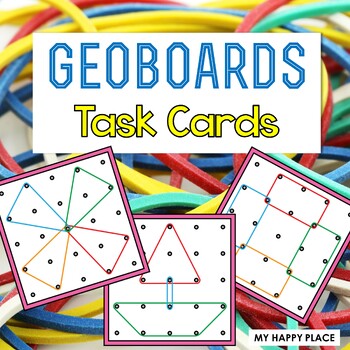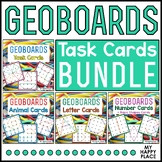Geoboards Task Cards - Fine Motor Activity - Spatial Reasoning - Morning Tub
- PDF
What educators are saying
Also included in
- This is a bundle of four sets of Geoboard task cards. These sets include printable task cards that are designed to be laminated and used with 5x5 peg geoboards and various sized rubber bands. Each set includes color and black and white versions of the cards in addition to printable recording sheets.Price $12.25Original Price $15.40Save $3.15
Description
These easy-prep geoboards task cards are a perfect fine motor activity for a math center, morning tubs, early finishers, or choice time! This set supports your teaching of geometry in the classroom by allowing students to build 2D shapes on geoboards.
This set is part of a money-saving Geoboard bundle. Check it out here!
What's Included in This Geoboard Task Cards Set?
This set includes 30 geoboard design task cards for students to replicate on their own geoboards. I have also included a blank geoboard task card for you to draw your own designs. These cards feature a 5x5 peg geoboard and are best used with a variety of sizes of rubber bands.
The task cards can be used alone as a springboard for creation. I have also included two recording sheets and a planning sheet for teachers who want to incorporate an accountability element into their center.
This set includes a black-and-white version of the task cards set in addition to the color version.
How Can I Use These Task Cards With My Class?
These geoboard task cards are a natural addition to math centers during your geometry unit. They can also be used year-round as a morning tub, early finisher activity, or even during indoor recess! These cards will bring new life to your classroom geoboards.
Encourage your students to think beyond the design templates on these cards. After they have mastered transferring a design onto their geoboard, they may become spurred to create their own pictures. This is a great way for young students to begin thinking about the shapes in their environment!
What Are Teachers Saying About These Geoboard Task Cards?
⭐⭐⭐⭐⭐ "I used these for geometry lessons, and I also had them in my morning work tubs and fast finishers. My students loved them!" -Haley C.
⭐⭐⭐⭐⭐ "I liked having these examples for students to follow. It takes exploring a math manipulative to the next level and gives a greater challenge, especially for students with weak spatial ability. It was easy to prepare and I used them with the whole group and in small group math centres. Thanks!"
-Jessica M.
⭐⭐⭐⭐⭐ "These geoboards task cards were super fun and engaging for my kindergartners. They were able to create and describe objects in the environment using names of shapes." -Lorraine V.
This set is part of a money-saving Geoboard bundle. Check it out here!
Here are some related resources:
➡️ Kindergarten Geometry Activities and Teaching Tools
➡️ Kindergarten Geometry Centers
➡️ Fine Motor Skills Task Boxes
Please see the preview file for more detailed images. If you have any questions, email susan@myhappyplaceteaching.com or use the “Q&A” feature on this page.
Let's keep in touch! Follow my store to be the first to know about sales and new resources.
Thank you for shopping!
Susan Jennings (My Happy Place)
Copyright © My Happy Place Teaching Resources
Permission to copy for single classroom use only.
Please purchase additional licenses if you intend to share this product.






